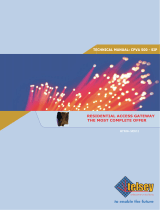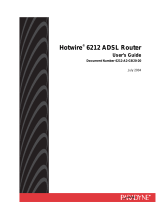Page is loading ...

Nokia M1122
T66280
USER MANUAL
ADSL Routerā

E Copyright Nokia Networks Oy
C33906002SE_00
1
M1122
ADSL Router
User Manual
C33906.21 A0
25.08.2000
1 Introduction to Nokia M1122
Nokia M1122 is an integrated ADSL (Asymmetric Digital Subscriber
Line) bridge and router which enables high-speed Internet access from
your Ethernet local area network (LAN). It multiplies the capacity of
the already installed telephone lines used traditionally for telephone
and dial-up modem services. M1122 brings high-speed connections
available for home users, small offices and telecommuters. An in-built
4-port hub allows easy home and small office network installation.
Figure 1 Nokia M1122

M1122 User Manual
E Copyright Nokia Networks Oy
C33906002SE_00
2
2 Installing M1122
Before you install M1122 you may want to familiarise yourself with
the interfaces and indicator lights of M1122. From section 2.3 you will
find a step-by-step installation procedure, which shows the physical
installation of M1122.
2.1 Interfaces
M1122 has one ADSL line interface and four LAN interfaces
(10Base-T Ethernet). It also has a local management interface (CLI)
for management purposes. The ADSL line interface is compatible with
ITU-T G.992.1 specification.
ADSL line (DSL)
Ethernet ports
(ETH-1, ETH-2,
ETH-3, ETH-4)
Command line interface (CLI)
Mains connector
Power switch
Figure 2 M1122 back panel
2.2 Indicator lights
M1122 has eight indicator lights on the front panel: PWR, STA, COL,
ETH-1, ETH-2, ETH-3, ETH-4, and DSL. STA indicator is red. Other
indicators are green.

E Copyright Nokia Networks Oy
C33906002SE_00
3
Figure 3 M1122 front panel indicators
DSL
GREEN
Off ADSL link is down.
Blinks ADSL connection is being established.
On ADSL link is up.
ETH-
GREEN
Off Ethernet is down.
On 10Base-T Ethernet is functional
Blinks Receives traffic from Ethernet.
COL
GREEN
Blinks Collisions on the Ethernet. Note, that it is normal that some
collisions occur on the Ethernet.
STA
RED
Off OK
On Hardware malfunction during startup.
PWR
GREEN
Off Power off.
On Power on.

M1122 User Manual
E Copyright Nokia Networks Oy
C33906002SE_00
4
2.3 Step-by-step installation procedure
splitter
Figure 4 M1122 with cables and splitter (T66270) connected
(Telephone and ADSL services)
1. Plug the mains power cord to a mains outlet.
2. Switch on M1122. The PWR indicator lights up. After a while, the
red STA indicator blinks and then remains unlit. M1122 is now
functional.
3. Connect the Ethernet cable between your PC’s 10Base-T
connector and the Ethernet connector on the M1122 back panel
(ETH-1, ETH-2, ETH-3, or ETH-4).
4. Switch on your PC. The indicator corresponding the Ethernet port
you connected your PC to becomes green when your PC has
started. This indicator blinks when there is traffic in the
corresponding Ethernet port.
5. Connect the ADSL line cable between the DSL connector on the
M1122 back panel and ADSL line wall socket. If you want to use
ADSL and telephone services simultaneously, connect the splitter
according to Figure 4. After a while, the DSL indicator starts
blinking. This indicates that the ADSL line is being established.
When the DSL indicator remains lit, the line is functional.
6. During normal operation PWR and DSL indicators are lit and the
Ethernet indicators of the active Ethernet ports blink or are lit
depending whether there is traffic or not. COL indicator may blink
occasionally during normal operation.

E Copyright Nokia Networks Oy
C33906002SE_00
5
Now, your M1122 has been connected and you can check the
connections according to your service provider’s instructions.
3 Configuring M1122
Your service provider has configured your M1122 for the service. Do
not change settings unless specifically asked by your service
provider. You can change M1122 settings with an ordinary web
browser such as Microsoft Internet Explorer or Netscape Navigator.
Use a PC connected to an ETH port of M1122 for configuration. In this
case the corresponding ETH indicator should be lit.
3.1 Browser management
You can use your PC’s web browser software to access the web
configuration pages in M1122. To access the web pages you must
know the IP address of your M1122 or, alternatively, the “name” that
your M1122 recognises.
Note
Before using your web browser for configuration, you must know the
IP address or the name assigned to your M1122.
There are three ways to find out whether to use a name or an IP
address:
D Your service provider has given you an IP address for M1122.
D Your M1122 uses Dynamic Host Configuration Protocol (DHCP)
and Domain Name Server. In this case the name is M1122.
D Your M1122 uses DHCP. In this case run winipcfg.exe (Windows
95) or ipconfig.exe (Windows NT). The IP address of M1122 is the
Default Gateway address shown by the ipconfig program.
3.1.1 Opening a connection
To open a connection to the Nokia M1122:
1. Start your web browser.
2. Enter the name (’M1122’) or IP address of your Nokia M1122 in
the browser’s Location or Address field and press Enter.

M1122 User Manual
E Copyright Nokia Networks Oy
C33906002SE_00
6
3. Type in the username/password as requested. If no
username/password is required, just click OK to proceed. The
Nokia M1122 Main Page appears.
3.1.2 Main Page
Main Page is shown first when you use a web browser to connect to
M1122. The list on the left shows the current page highlighted.
Clicking an item on the list (Service Providers, Local Network,
Statistics, Restart, and Save Config) takes you to the corresponding
page.
Note
When you make modifications to the configuration, remember to save
the configuration and restart your M1122 for your changes to take
effect.
Figure 5 Main Page

E Copyright Nokia Networks Oy
C33906002SE_00
7
The Main Page shows you the statuses of the DSL line and the Ethernet
interfaces. Software and hardware versions and the serial number of
M1122 are shown in the bottom of the page.
3.1.3 Service Providers pages
The Service Providers page can be used to set authentication for ATM
VCCs with PPP encapsulation (Figure 6). You can set the
Authentication method and the corresponding Username and
Password. You can also view Network connection information in the
bottom of the page. If you are using PPTP encapsulation, you can
change the name of the connection through the Service Providers page
(Figure 7).
Figure 6 Service Providers page with PPP configuration

M1122 User Manual
E Copyright Nokia Networks Oy
C33906002SE_00
8
Figure 7 Service Providers page with PPTP configuration

E Copyright Nokia Networks Oy
C33906002SE_00
9
3.1.4 Local Network pages
The Local Network page as four sub pages: Local ports, DHCP, NAPT,
and Routing.
Local ports
On the Local Network Local Ports sub page you can assign an IP
address to the Ethernet ports.
Note
When you click Apply, the IP addresses are changed immediately. If
the IP address of the interface you are using changes the connection
will be lost. You have to reconfigure the IP address of the accessing
host. For example, in Windows programs winipcfg.exe or
ipconfig.exe must be used first to release the old address and then to
renew to request new address.
Figure 8 Local Network Local Ports page
DHCP
On the Local Network DHCP subpage you can enable/disable
Dynamic Host Control Protocol and set the Address ranges from
which the addresses are distributed to the DHCP clients on your
network. You can also set the Domain Name Server addresses here.

M1122 User Manual
E Copyright Nokia Networks Oy
C33906002SE_00
10
Start address is the first address in the address range. The Range size
defines how many addresses the range contains. Subnet mask is the
subnet mask of the addresses in the range. Primary and Secondary
DNSs set the domain name servers for the corresponding address
range. Lease time defines how often the DHCP client must renew its
lease. Domain name defines the domain name for the range.
The DHCP server can be enabled towards LAN and VBRIDGE
(gateway interface) ports. When the DHCP server is enabled, up to two
scopes (address ranges) are automatically generated and bound to
LAN/VBRIDGE interfaces, in this order if the interface has an IP
address. Two separate address ranges can be used if more than 253
addresses are required on the local subnet, if two non-contiguous
ranges are needed or if an additional router with a DHCP relay is used
on the local network. In Figure 9, scope (a) is has been bound to
Ethernet interface and scope (b) to VBRIDGE interface. When the
address ranges are not defined, M1122 uses the default values for all
DHCP parameters. The default values are:
D Start address is the interface IP address
D Subnet mask 255.255.255.0
D Range size of up to 253 addresses starting from the interface IP
address.
D DNS address is the interface IP address
D Lease time is 60 minutes
D Domain name is null string
If at least one address range has been defined, then IP address, DNS,
domain name and lease time, if defined, override the default values.

E Copyright Nokia Networks Oy
C33906002SE_00
11
Figure 9 Local Network DHCP page

M1122 User Manual
E Copyright Nokia Networks Oy
C33906002SE_00
12
NAPT
If Network Address Port Translation (NAPT) has been activated,
servers on your local network are not visible outside your network. On
NAPT page, you can configure pinholes through which you can
provide outside access to your web server from the Internet, for
example.
In the example shown in Figure 10, a pinhole has been added on the
Server list. This example means that all TCP traffic coming from the
Internet through VCC1 to ports 80...89 will be mapped to the IP
address 192.168.1.15 ports 90...99 on your local network.
Figure 10 Local Network NAPT page

E Copyright Nokia Networks Oy
C33906002SE_00
13
Routing page
On the Local Network Routing sub page you can set static routes and
enable/disable dynamic routing protocols (Routing Information
Protocol version 1 and 2).
To enable dynamic routing to a particular interface select the Routing
protocol version from the pull-down list and click the Apply button.
RIP versions 1 and 2 are supported. Send v1-compat. v2 option enables
the sending of RIPv2 packets using broadcast. Receive v1-compat. v2
option enables the receiving of both RIPv1 and RIPv2 packets.
To add a static route, type in the Destination network IP address, the
Subnet mask of the destination network, and the Gateway and the
Interface through which the destination network can be reached. Then
click the Add new button. There are two static routes in Figure 11.
Figure 11 Local Network Routing page

M1122 User Manual
E Copyright Nokia Networks Oy
C33906002SE_00
14
3.1.5 Statistics page
The Statistics page lets you view a selection of M1122 statistics. to
view statistics of a particular function, click the corresponding button
and the statistics view is opened on a separate window.
Figure 12 Statistics page

E Copyright Nokia Networks Oy
C33906002SE_00
15
3.1.6 Restart page
On the Restart page, you can reset subsystems and restart M1122.
Figure 13 Restart page

M1122 User Manual
E Copyright Nokia Networks Oy
C33906002SE_00
16
3.1.7 Save Config page
When you change the configuration, all configuration changes are
activated immediately without restart/reload. However, the
configuration will not be saved into the nonvolatile memory. If M1122
is restarted or powered down without saving the configuration, the old
configuration will be restored. Clicking the Save configuration button
saves the configuration into the nonvolatile memory and the old
configuration cannot be restored through the web interface.
Figure 14 Save Config page
4 Features
M1122 can operate as a bridge and/or Internet Protocol (IP) router
between Ethernet and the virtual channels of ADSL/ATM interfaces
supporting both dynamic and static routing.
4.1 Interfaces
M1122 has the following interfaces:
D Four Ethernet interfaces (LAN)
D 8 ATM VCC interfaces
D ATM VCC management interface

E Copyright Nokia Networks Oy
C33906002SE_00
17
D Gateway/bridge management interface. This interface is used as a
bridge host interface or gateway interface depending on the
operation mode. In this manual it is called VBRIDGE. On the
M1122 web pages, the interface is called gateway or bridge IP
interface.
M1122 can operate in four different main modes:
D Bridging only
D Routing/tunneling IP only
D Routing/tunneling IP, bridging all but IP
D Routing/tunneling IP and bridging all, including IP
The mode in which M1122 operates depends on the configuration of
the unit’s interfaces.
LAN interface
LAN interface can be configured to bridge and route packets. There are
three different operational modes in the LAN interface:
D Bridging only; only bridging is activated in the interface. In this
case the interface bridges all protocols.
D Routing only; only IP address is configured in the interface. In this
case, the interface routes IP packets.
D Bridging and routing; Bridging is activated in the interface and IP
address is configured in the interface. In this case, the interface
routes IP packets and bridges all other packets.
Internal host/gateway interface
There is a special host/gateway logical IP interface within M1122
called VBRIDGE. This interface has a specific purpose in M1122. In
applications where some ATM virtual channel connections are used
for bridging IP traffic and some other ATM virtual channel
connections are used for routing IP traffic, the VBRIDGE interface
must be used instead of LAN IP addresses. Alternatively, this interface
is used in bridge only application when the IP address is required for
remote management purposes.
Data VCC operation
M1122 supports the following encapsulations in each ATM data
virtual channel individually:
D RFC2684 LLC encapsulation for bridged IP (ETH-LLC)
D RFC2684 LLC encapsulation for routed IP (IP-LLC)

M1122 User Manual
E Copyright Nokia Networks Oy
C33906002SE_00
18
D RFC2364 Virtual circuit multiplexed PPP over AAL5 (PPP-VC)
D RFC2364 Virtual circuit multiplexed PPP over AAL5 used to
tunnel LAN/VBRIDGE PPTP packets
(TUNNELED-PPP-VC)
If an IP address is given to a virtual channel interface and bridging is
enabled at that interface, then IP data at that interface is routed and all
other protocols are bridged. The only encapsulation which allows both
bridging and routing simultaneously is ETH-LLC. For example, it is
possible to route ETH-LLC encapsulated packets and at the same time
bridge, for example, PPPoE packets (PPPoE packets are transported
directly over Ethernet frame, not within IP packets).
4.2 Routing
Routing is based on routing entries in a routing table. Static routes are
added via the management interface and dynamic routing is done using
RIP and RIPv2. Routing is done between the Ethernet 10Base-T
interface and the virtual channel connection (VCC) of the ATM/ADSL
interface. M1122 supports up to 8 simultaneous VCCs.
M1122 supports IGMP (Internet Group Management Protocol) proxy
receive function for IP multicast applications.
4.3 Bridging
Bridging is supported to provide full protocol transparency. Bridging
can be used simultaneously with IP routing. M1122 works as a
self-learning bridge supporting up to 1024 MAC addresses. Bridging
is done between the Ethernet 10Base-T interface and each ATM VCC
interface. Optionally, the bridging between the VCCs can be disabled.
4.4 Network Address Port Translation
M1122 supports Network Address Port Translation (NAPT) for
TCP/IP, UDP/IP and ICMP/IP protocols. When NAPT is used, a single
IP address is allocated to a VCC which leads to the public IP network.
The Ethernet subnet has private IP addressing and is not visible to the
VCC. NAPT translates the IP source address and source port number
dynamically to the VCC IP address and port number. Similarly,
packets coming from the VCC are mapped back to the original
destination addresses. NAPT allows up to hundreds of hosts to share a

E Copyright Nokia Networks Oy
C33906002SE_00
19
single VCC IP address to the public network. The principle of Network
Address Port Translation is presented in Figure 15.
NAPT router
192.168.1.254
195.112.12.161
src:192.168.1.112:1228
dst:194.112.11.111:80
src:194.112.11.111:80
dst:192.168.1.112:1228
src:195.112.12.161:50001
dst:194.112.11.111:80
src:194.112.11.111:80
dst:195.112.12.161:50001
Home network (LAN) Internet (WAN)
Figure 15 Principle of Network Address Port Translation
NAPT may restrict the operation of some IP applications. NAPT also
operates as a simple IP firewall because translation is only allowed
when the first packet is transmitted from the LAN. This means that the
NAPT table entry is created only when a packet is sent from the home
network to the Internet. With server support capability, the user can
add static entries to the NAPT table allowing the translation always in
both directions. This capability is used to add servers (HTTP, NNTP,
and FTP), which are visible to the public IP network via the VCC, on
the LAN subnet.
NAPT supports most IP-based protocols. Because NAPT operates on
the IP and transport layer, the application that includes IP address and
port within the payload will not work properly through NAPT. In many
cases, these applications can be passed through the NAPT using
Application Layer Gateway functionality (ALG). M1122 has ALG for
the following protocols/applications:
D ICMP
D FTP
D H.323 including NetMeeting
D CUSeeMe
D PPTP
D IRC
D IPSEC ESP tunnel mode and IKE
Note, that most IPSEC implementations will fail when passed through
NAPT. A typical reason is that the identification may fail if the
identification is based on IP address. Also, only tunnel mode without
Authentication Header (AH) works.
/


